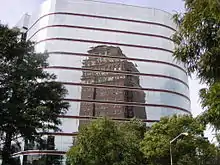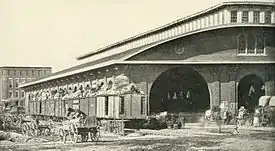Architecture of Atlanta
The architecture of Atlanta is marked by a confluence of classical, modernist, post-modernist, and contemporary architectural styles. Due to the complete destruction of Atlanta by fire in 1864, the city's architecture retains no traces of its Antebellum past. Instead, Atlanta's status as a largely post-modern American city is reflected in its architecture, as the city has often been the earliest, if not the first, to showcase new architectural concepts. However, Atlanta's embrace of modernism has translated into an ambivalence toward architectural preservation, resulting in the destruction of architectural masterpieces, including the Commercial-style Equitable Building (Atlanta's first skyscraper), the Beaux-Arts style Terminal Station, and the Classical Carnegie Library. The city's cultural icon, the Neo-Moorish Fox Theatre, would have met the same fate had it not been for a grassroots effort to save it in the mid-1970s.[1]


History

Antebellum
Because Atlanta was a settlement that grew from a planned railroad terminus and later a railroad junction, rather than being planned in a grand manner, its antebellum architecture was unremarkable compared to patrician Savannah or other older Southern cities. The town's most important buildings included Edward A. Vincent's Union Station (1853), the Atlanta, Trout House and Washington Hall hotels, and the Atlanta Bank. An 1859 industrial journal noted that:[2]
19 commodious brick stores were erected in 1858…besides a large number of fine residences, mostly of brick. Many of the new improvements are imposing structures, and would not suffer by comparison with the most elegant portions of our modern cities.

Not a single antebellum building from what was the town of Atlanta remains today. Remaining antebellum architecture inside the city limits consists of four houses that were well outside the city limits in the 19th century, as well as the Tullie Smith House which was moved to the Atlanta History Center from a location in North Druid Hills, an adjacent suburb.[3] The oldest building in Downtown Atlanta is the Georgia Railroad Freight Depot (1869).
Postbellum


Most of Atlanta was burned during the Civil War, depleting the city of a large stock of its historic architecture. Yet Atlanta, architecturally, had never been particularly "southern." Because Atlanta originated as a railroad town, rather than a patrician southern seaport like Savannah or Charleston, many of the city's landmarks could have easily been erected in the Northeast or Midwest,[1] and indeed this was one reason why Atlanta referred to itself frequently as "the New York" or "the Chicago of the South."[4][5][6][7]
Throughout the American Renaissance and beyond, Atlantans were amazed at successive waves of ever more impressive hotels, civic and industrial architecture, and office buildings, such as the Equitable Building (8 stories, 1892), Candler Building (17 stories, 1906), and Rhodes-Haverty Building (21 stories, 1929). Among the most notable architects active in Atlanta between the Civil War and World War Two were A. Ten Eyck Brown, Francis Palmer Smith and G. Lloyd Preacher.
Cold War Era

During the Cold War era, Atlanta followed global modernist trends, especially with regards to office towers and commercial buildings. Examples of modernist architecture include the Westin Peachtree Plaza (1976), Georgia-Pacific Tower (1982), the State of Georgia Building (1966), and the Atlanta Marriott Marquis (1985).
The era's most notable architect may be Atlanta-native John Portman, whose Hyatt Regency Hotel (1968) made a significant mark on the hospitality sector. A graduate of Georgia Tech's College of Architecture, Portman's work reshaped downtown Atlanta with his designs for the Atlanta Merchandise Mart, Peachtree Center, the Westin Peachtree Plaza Hotel, and SunTrust Plaza.
Contemporary Era

In the latter half of the 1980s, Atlanta became one of the early-adopters of postmodern designs which reintroduced classical elements to the cityscape. Many of Atlanta's tallest skyscrapers were built from the late 1980s to the early 1990s, with most displaying tapering spires or otherwise ornamented crowns, such as One Atlantic Center (1987), 191 Peachtree Tower (1991), and the Four Seasons Hotel Atlanta (1992). And at 1,023 feet (312 m), Atlanta's tallest skyscraper—the Bank of America Plaza (1992)—is the 61st-tallest building in the world and the 9th tallest building in the United States.[8]
More recently, Atlanta's built environment has been getting more eclectic and diverse. For example, 3344 Peachtree (2008) is more in the glass-walled modernist vein, while Millennium Gate (also completed in 2008) is the largest classical monument in the U.S. to have been dedicated since completion of the Jefferson Memorial in Washington, D.C.[9]
Repurposed industrial architecture

With the dawn of the twenty-first century, many former industrial buildings were repurposed for residential and retail use, many along the BeltLine, former railroad rights-of-way which became a ring of trails around the central city. Examples are Ponce City Market, Krog Street Market, Telephone Factory Lofts, Fulton Bag and Cotton Mills, King Plow and Goat Farm Arts Centers and many others, particularly in the Old Fourth Ward, Inman Park Village, Cabbagetown and Reynoldstown, and the Marietta Street Artery.
Notable Architecture
Arts facilities have led the way for modernists in Atlanta architecture with the High Museum designed by Richard Meier with a 2005 addition by Renzo Piano. A recent design competition resulted in Freelon Associates (in conjunction with HOK) being selected as the architect for the new $100 million home of the Center for Civil and Human Rights. Michael Graves' post-modern style is exhibited in the Ten Peachtree Place office building in Midtown and the Michael C. Carlos Museum on the campus of Emory University. The 50-story One Atlantic Center was designed by Philip Johnson in association with John Burgee. Completed in 1980, the Atlanta-Fulton Central Public Library was designed by one of the 20th century's most notable modernists architects, Marcel Breuer, who holds the distinction of having studied and taught at the Bauhaus, where early in his career Breuer first became a renowned furniture designer. Atlanta also has its own Flatiron Building, built in 1897, five years before the more famous Flatiron Building in New York City (1902).[10]
Skyscrapers
| Rank | Name | Height ft (m) |
Floors | Year | Notes |
|---|---|---|---|---|---|
| 1 | Bank of America Plaza | 1,023 (312) | 55 | 1992 | 63rd-tallest building in the world, 10th-tallest in the U.S. Has been the tallest building in Atlanta, Georgia and the Southern United States since 1992. Tallest building in any U.S. state capital.[11] |
| 2 | SunTrust Plaza | 871 (265) | 60 | 1992 | 77th-tallest building in the world, 25th-tallest in the U.S.[12] |
| 3 | One Atlantic Center | 820 (250) | 50 | 1987 | 125th-tallest building in the world, 38th-tallest in the U.S. Also known as the IBM Tower.[13][14][15] |
| 4 | 191 Peachtree Tower | 770 (235) | 50 | 1990 | 200th-tallest building in the world, 57th-tallest in the U.S.[16][17] |
| 5 | Westin Peachtree Plaza Hotel | 723 (220) | 73 | 1976 | 93rd-tallest building in the U.S. Stood as the tallest all-hotel building in the world from 1976 until 1977.[18][19] |
| 6 | Georgia-Pacific Tower | 697 (212) | 52 | 1982 | [20][21] Total building area is 1,567,011 sq.ft.[22] |
| 7 | Promenade II | 691 (211) | 38 | 1990 | [23][24] |
| 8 | AT&T Midtown Center | 677 (206) | 47 | 1982 | Also known as the BellSouth Building.[25][26] |
| 9 | 3344 Peachtree | 665 (203) | 48 | 2008 | Also known as the Sovereign.[27][28] |
| 10 | 1180 Peachtree | 657 (200) | 41 | 2006 | Formerly known as the Symphony Center.[29][30] |
Firms, Universities, and Organizations


Atlanta is home to the award-winning, internationally acclaimed Mack Scogin Merrill Elam Architects (formerly Scogin, Elam and Bray Architects). Contemporary practices include BLDGS, Lightroom, Dencity, G+G Architects, Houser Walker Architecture, plexus r+d, Smith Dalia, Square Feet Studio, and Robert M. Cain, Architect. Large firms include Stevens & Wilkinson, Perkins and Will (Owned by Dar Al-Handasah), Collins Cooper Carusi, TVS (Thompson, Ventulett, Stainback & Associates), Lord Aeck Sargent a Katerra Company, Smallwood, Reynolds, Stewart, Stewart & Associates, and Cooper Carry Inc.
The Georgia Institute of Technology College of Architecture, located just west of midtown Atlanta offers both pre-professional undergraduate and professional graduate degrees in architecture, and hosts regular lectures and symposia of interest to students and professionals. Kennesaw State University formerly known as Southern Polytechnic State University in Marietta, a suburb of Atlanta, offers a five-year professional undergraduate degree and also hosts lectures and exhibits works in the architecture building's gallery space.
The Young Architects Forum of the Atlanta chapter of the American Institute of Architects sponsors open design competitions, exhibits, and lectures of interest to the profession and the general public.
References
- Gournay, Isabelle. AIA Guide to the Architecture of Atlanta. University of Georgia Press. ISBN 978-0820314501.
- Bow, James Dunwoody Brownson De; Burwell, William MacCreary (1 January 1859). DeBow's Review. J.D.B. De Bow. p. 464. Retrieved 19 February 2017 – via Internet Archive.
- Jones, Tommy H. "Tullie Smith House - Original Site and Outbuildings". tomitronics.com. Retrieved 19 February 2017.
- Sources documented on Barry Popik's Big Apple blog:
- 5 October 1872, Appletons' Journal of Literature, Science and Art, pg. 376: "Marvellous tales are told of this antique period in the history of the present "New York of the South," concerning acres upon acres of land, near the heart of the city, selling for fifty cents per acre, but which now are worth a snug little fortune. Such was Atlanta less than three decades ago."
- 17 June 1879, Daily Constitution (Atlanta, GA), pg. 4: "...the future New York of the south - as it was predicted at the opening of the Port Royal railroad in 1873."
- 6 July 1881, New York Times, pg. 4: "The New-Orleans Democrat says that that city is the New-York of the South, and yet has no public library."
- 29 January 1884, Atlanta Constitution, pg. 4: "The New York of the South. From the New York Tribune: THE ATLANTA CONSTITUTION draws a sad picture of its environment. "Within one hundred yards of the officer," is its plaintive mean, "wagons are literally up to the hub in mud. Part of Ellis street, in a quarter mile of the depot, is literally impassable." Assuming that our contemporary's account of these wagons and this streets is literally correct, it looks as if Atlanta was likely to be known as the New York of the south."
- 12 November 1891, Atlanta Constitution, pg. 4: "Atlanta is a grand city. It is the New York of the south, and henceforth it can get the finest attractions produced, for its patronage is sufficient to make the very best and most expensive show a financial success."
- 21 October 1892, Atlanta Constitution, pg. 5: "Work will cease altogether and the New York of the south will pay honor to the brave navigator, who in spite of the hardships he had to endure, pointed out a new land to the ignorant people of the time."
- 19 January 1895, Atlanta Constitution, pg. 4: "Cedartown Standard: Atlanta aspires to be the New York of the south - in fact, she is, and so it is perfectly natural that she should follow New York in having the big police scandal and investigation that is now on hand
- "Proceedings of the Annual Convention - National Association of Life Underwriters / Life Underwriters Association of Canada". 1893. p. 62. Retrieved 19 February 2017 – via Google Books.
- Cooper, Jr, William J.; Terrill, Thomas E. (16 January 2009). "The American South: A History". Rowman & Littlefield Publishers. p. 529. Retrieved 19 February 2017 – via Google Books.
- Still, Bayrd (1 January 1974). Urban America: a history with documents. Little, Brown. Retrieved 19 February 2017 – via Internet Archive.
chicago of the south.
- "World's Tallest Buildings". Infoplease. Retrieved June 26, 2007.
- "Triumphal March". PALLADIO AWARDS. Retrieved January 26, 2012.
- Flatiron Building history Archived April 5, 2004, at the Wayback Machine
- "Bank of America Plaza". SkyscraperPage.com. Archived from the original on 15 January 2008. Retrieved 2007-12-25.
- "SunTrust Plaza". SkyscraperPage.com. Archived from the original on 19 December 2007. Retrieved 2007-12-25.
- "One Atlantic Center". Emporis.com. Retrieved 2007-12-25.
- "One Atlantic Center". SkyscraperPage.com. Archived from the original on 3 December 2007. Retrieved 2007-12-25.
- "One Atlantic Center". Glass Steel and Stone. Artefaqs Corporation. Archived from the original on 2008-12-04. Retrieved 2008-05-31.
- "191 Peachtree Tower". Emporis.com. Retrieved 2007-12-25.
- "191 Peachtree Tower". SkyscraperPage.com. Archived from the original on 1 January 2008. Retrieved 2007-12-25.
- "Westin Peachtree Plaza". Emporis.com. Retrieved 2008-05-15.
- "Westin Peachtree Plaza". SkyscraperPage.com. Archived from the original on 24 April 2008. Retrieved 2008-05-15.
- "Georgia Pacific Tower". Emporis.com. Retrieved 2007-12-25.
- "Georgia Pacific Tower". SkyscraperPage.com. Archived from the original on 19 December 2007. Retrieved 2007-12-25.
- "Georgia-Pacific Center". CrediFi. Retrieved 16 October 2016.
- "Promenade II". Emporis.com. Retrieved 2007-12-25.
- "Promenade 2". SkyscraperPage.com. Archived from the original on 19 December 2007. Retrieved 2007-12-25.
- "AT&T Building". Emporis.com. Retrieved 2007-12-25.
- "BellSouth Building". SkyscraperPage.com. Archived from the original on 19 December 2007. Retrieved 2007-12-25.
- "Sovereign". Emporis.com. Retrieved 2008-05-15.
- "Sovereign". SkyscraperPage.com. Archived from the original on 24 April 2008. Retrieved 2008-05-15.
- "1180 Peachtree". Emporis.com. Retrieved 2007-12-25.
- "1180 Peachtree". SkyscraperPage.com. Archived from the original on 19 December 2007. Retrieved 2007-12-25.

